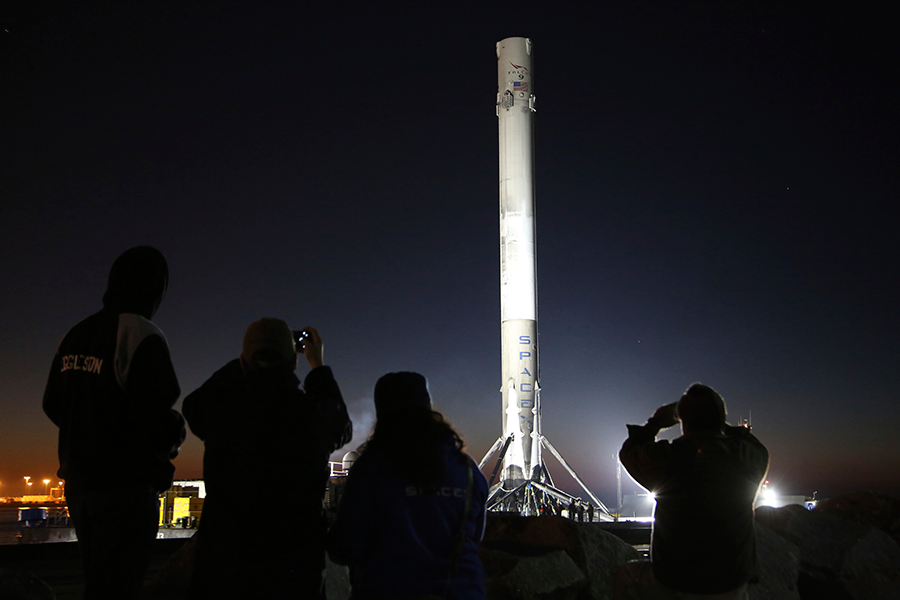No landing: SpaceX to retire this model of the Falcon 9 rocket
Loading...
SpaceX's current Falcon 9 rocket may soon be heading for retirement.
Responding to a question via Twitter on Saturday, SpaceX founder Elon Musk confirmed that the aerospace startup plans to shift to its improved reusable Block 5 Falcon 9 or Falcon Heavy rockets for delivery of even heavier payloads into space.
Reusable rockets are a linchpin for Mr. Musk's vision for the future of spaceflight, as they hold the potential to dramatically slash the cost of reaching low-Earth orbit. For that reason, space agencies around the world, as well as other private spaceflight companies are closely watching the progress of SpaceX reusable rockets.
“If one can figure out how to effectively reuse rockets just like airplanes, the cost of access to space will be reduced by as much as a factor of a hundred," Musk said in a SpaceX statement in 2013. "A fully reusable vehicle has never been done before. That really is the fundamental breakthrough needed to revolutionize access to space.”
The company says that each Falcon 9 cost $62 million to build (roughly equivalent to the cost of a commercial airliner, it says) but the cost of fuel for each flight is just $200,000. So, most of the cost for each rocket is in the build not the fuel. "Following the commercial [airline] model, a rapidly reusable space launch vehicle could reduce the cost of reaching Earth orbit by a hundredfold," the company explains.
Critics note that the refurbishing the first stage of the Falcon 9 for reuse will not be cheap, so the actual cost savings might be around $30 million per launch.
The upcoming launch, which could take place as soon as Jan. 30, will also use a expendable rocket. According to Musk, however, the expectation is it will be the last of this version of the Falcon 9 rocket to do so and that future flights will utilize technologically upgraded rockets that allow for greater ease of reusability.
“Next SpaceX flight (Echostar) has v heavy GTO payload (5500kg) Will Falcon fly expendable, or try low-margin droneship landing?” a Twitter user asked Elon Musk on Saturday, Jan. 21.
“Expendable. Future flights will go on Falcon Heavy or the upgraded Falcon 9,” Musk replied, adding “Block 5 is the final upgrade of the Falcon architecture. Significantly improves performance & ease of reusability. Flies end of year.”
The Falcon 9 refers to the family of two-stage rockets designed and developed by SpaceX, named for its nine first-stage engines.
The Falcon 9 made its initial successful flight in 2012, delivering a Dragon Capsule to the International Space Station. The rocket most recently made headlines, however, after a rocket exploded at Cape Canaveral Air Force Station in September of 2016. The explosion destroyed the $200 million Amos 6 satellite that it was set to deliver into orbit.
The cost of the satellite was only the last of the string of heavy losses SpaceX faced, starting when another Falcon 9 rocket exploded after takeoff in June of 2015. That launch cost the company tens of millions of dollars plus the $112 million equipment from NASA, and it began a five-month long hiatus where SpaceX missed six proposed launches and thus an anticipated revenue of over $370 million.
The successful Jan. 14 launch marked an important return to flight for SpaceX as the company prepares to embark on a busy schedule, aiming to launch 60 satellites in the upcoming months.
As SpaceX continues to push the number of flights made each year, it becomes increasingly important to utilize reusable rockets.
According to a chart provided by the company, each Falcon 9 launch costs about $62 million, however “the max performance numbers are for expendable launchers. Subtract 30% to 40% for reusable booster payload,” said Musk on Twitter.
In an Ask Me Anything question and answer session on the website Reddit, Musk elaborated, “Falcon 9 Block 5 -- the final version in the series -- is the one that has the most performance and is designed for easy reuse, so it just makes sense to focus on that long term and retire the earlier versions. Block 5 starts production in about 3 months and initial flight is in 6 to 8 months, so there isn't much point in ground testing Block 3 or 4 much beyond a few reflights.”
Additionally, the maximum payload potential for the Falcon Heavy is significantly higher than that of the Falcon 9, thus further minimizing expenses by facilitating greater load delivery off of fewer launches.
The upcoming flight expects to deliver the EchoStar 23 communications satellite to geostationary transfer orbit (the intermediary step leading to geostationary orbit) sometime after Jan. 30. The sheer weight of the satellite will require almost all of the rockets lift capacity, leaving an insufficient amount of fuel to attempt a controlled descent on a drone ship for later reuse.








